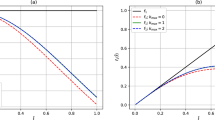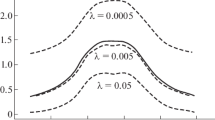Abstract
In this work, we propose a method combining the Sinc collocation method with the double exponential transformation for computing the eigenvalues of the anharmonic Coulombic potential. We introduce a scaling factor that improves the convergence speed and the stability of the method. Further, we apply this method to Coulombic potentials leading to a highly efficient and accurate computation of the eigenvalues.


Similar content being viewed by others
References
R. Roychoudhury, Y.P. Varshni, M. Sengupta, Family of exact solutions for the Coulomb potential perturbed by a polynomial in r. Phys. Rev. A 42(1), 184–192 (1990)
O. Ozer, B. Gonul, New exact treatment of the perturbed Coulomb interactions. Mod. Phys. Lett. A 18(36), 2581–2586 (2003)
R.N. Chaudhuri, M. Mondal, Eigenvalues of anharmonic oscillators and the perturbed Coulomb problem in N-dimensional space. Phys. Rev. A 52(3), 1850–1856 (1995)
S.M. Ikhdair, R. Sever, An alternative simple solution of the sextic anharmonic oscillator and perturbed Coulomb problems. Int. J. Mod. Phys. C 18(10), 1571–1581 (2007)
F.M. Fernández, Calculation of bound states and resonances in perturbed Coulomb models. Phys. Lett. A 372(17), 2956–2958 (2008)
J.R. Lund, B.V. Riley, A sinc-collocation method for the computation of the eigenvalues of the radial Schrödinger equation. IMA J. Numer. Anal. 4(1), 83–98 (1984)
M. Tater, The Hill determinant method in application to the sextic oscillator: limitations and improvement. J. Phys. A. Math. Gen. 20(9), 2483–2495 (1987)
F.M. Fernández, Exact and approximate solutions to the Schrödinger equation for the harmonic oscillator with a singular perturbation. Phys. Lett. A 160(6), 511–514 (1991)
F.M. Fernandez, Q. Ma, R.H. Tipping, Eigenvalues of the Schrodinger equation via the Riccati-Pade method. Phys. Rev. A 40(11), 6149–6153 (1989)
F. Stenger, A Sinc-Galerkin method of solution of boundary value problems. Math. Comput. 33, 85–109 (1979)
F. Stenger, Numerical methods based on Whittaker cardinal, or Sinc functions. SIAM Rev. 23, 165–224 (1981)
F. Stenger, Summary of Sinc numerical methods. J. Comput. Appl. Math. 121, 379–420 (2000)
P. Gaudreau, R.M. Slevinsky, H. Safouhi, Computing energy eigenvalues of anharmonic oscillators using the double exponential Sinc collocation method. Ann. Phys. 360, 520–538 (2015)
P. Gaudreau, R.M. Slevinsky, H. Safouhi, The double exponential Sinc collocation method for singular Sturm–Liouville problems. J. Math. Phys. 57(4), 1–19 (2016)
R.M. Corless, G.H. Gonnet, D.E.G. Hare, D.J. Jeffrey, D.E. Knuth, On the Lambert W function. Adv. Comput. Math. 5(1), 329–359 (1996)
K. Al-Khaled, Sinc numerical solution for solitons and solitary waves. J. Comput. Appl. Math. 130, 283–292 (2001)
K. Al-Khaled, Numerical study of Fisher’s reaction-diffusion equation by the Sinc collocation method. J. Comput. Appl. Math. 137, 245–255 (2001)
T.S. Carlson, J. Dockery, J. Lund, A Sinc-collocation method for initial value problems. Math. Comput. 66, 215–235 (1997)
P. Amore, A variational Sinc collocation method for strong-coupling problems. J. Phys. A Math. Gen. 39, L349–L355 (2006)
M. El-Gamel, A.I. Zayed, Sinc-Galerkin method for solving nonlinear boundary-value problems. Comput. Math. Appl. 48, 1285–1298 (2004)
M. El-Gamel, J.R. Cannon, A.I. Zayed, Sinc-Galerkin method for solving linear sixth-order boundary-value problems. Math. Comput. 73, 1325–1343 (2003)
R.C. Smith, G.A. Bogar, K.L. Bowers, J. Lund, The Sinc-Galerkin method for fourth-order differential equations. SIAM J. Numer. Anal. 28, 760–788 (1991)
N. Eggert, M. Jarratt, J. Lund, Sinc function computation of the eigenvalues of Sturm–Liouville problems. J. Comput. Phys. 69(1), 209–229 (1987)
H. Takahasi, M. Mori, Double exponential formulas for numerical integration. RIMS 9, 721–741 (1974)
M. Mori, M. Sugihara, The double-exponential transformation in numerical analysis. J. Comput. Appl. Math. 127(1–2), 287–296 (2001)
M. Sugihara, Near optimality of the sinc approximation. Math. Comput. 72(242), 767–786 (2002)
K. Tanaka, M. Sugihara, K. Murota, Function classes for successful DE-Sinc approximations. Math. Comput. 78(267), 1553–1571 (2009)
M. Sugihara, Double exponential transformation in the Sinc-collocation method for two-point boundary value problems. J. Comput. Appl. Math. 149(1), 239–250 (2002)
M. Mori, Discovery of the double exponential and its developments. Publ. Res. Inst. Math. Sci. 41(4), 897–935 (2005)
T. Okayama, K. Tanaka, T. Matsuo, M. Sugihara, DE-Sinc methods have almost the same convergence property as SE-Sinc methods even for a family of functions fitting the SE-Sinc methods. Numer. Math. 125(3), 511–543 (2013)
K. Tanaka, T. Okayama, T. Matsuo, M. Sugihara, DE-Sinc methods have almost the same convergence property as SE-Sinc methods even for a family of functions fitting the SE-Sinc methods. Numer. Math. 125(3), 545–568 (2013)
M. Mori, An error analysis of quadrature formulas obtained by variable transformation, in Algebraic Anaylsis, vol. 1, ed. by M. Kashiwara, M. Jimbo, T. Kawai, H. Komatsu, T. Miwa, M. Morimoto (Academic Press, London, 1988), pp. 423–437
MATLAB Student R2014b, The MathWorks, Inc., Natick
Author information
Authors and Affiliations
Corresponding author
Additional information
The corresponding author acknowledges the financial support for this research by the Natural Sciences and Engineering Research Council of Canada (NSERC) - Grant RGPIN-2016-04317.
Rights and permissions
About this article
Cite this article
Cassidy, T., Gaudreau, P. & Safouhi, H. On the Computation of Eigenvalues of the Anharmonic Coulombic Potential. J Math Chem 56, 477–492 (2018). https://doi.org/10.1007/s10910-017-0801-5
Received:
Accepted:
Published:
Issue Date:
DOI: https://doi.org/10.1007/s10910-017-0801-5
Keywords
- Coulombic anharmonic potentials
- Schrödinger equation
- Sinc collocation method
- Double exponential transformation




